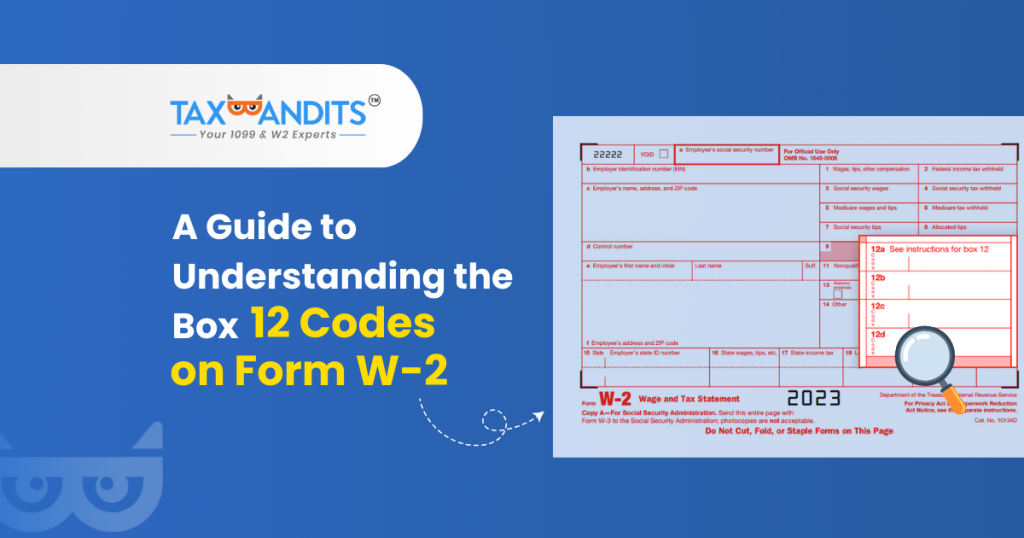A Guide to Understanding the Box 12 Codes on Form W-2

It is that time of year again! The holiday season is now in full swing but the tax season is also kicking off! That means it’s time to get reacquainted with Form W-2 for the 2023 tax year.
As always the TaxBandits team is here to provide you with the helpful information that you need for a smooth season.
Let’s cover Form W-2 and the series of slightly confusing codes that come with it in Box 12.
What is Form W-2?
Form W2 is a wage form that reports the wages an employee earned from their employer during the year with a breakdown of the taxes withheld. Employees need a copy of Form W-2 to file their own state and federal income taxes.
Who is Required to File Form W-2?
All employers that pay wages to their employees, even if the employee is a relative, are required to complete and file Form W-2 with the Social Security Agency (SSA) each year.
This form is used to report the wages and withholding to the IRS. A copy must also be distributed to employees, without the wage information on Form W-2, they are unable to accurately file their own personal income tax returns with the IRS.
What are the Codes used on Form W-2?
The W2 box 12 codes allow employers to further itemize their employees’ earnings and provide them with any additional information that will be helpful to them. On lines 12a, 12b, 12c, and 12d, employers can enter any of the codes A-HH.
Employers can enter up to 4 different codes, depending on what information applies to the employee. For example, more details on uncollected tax amounts, deferrals, and IRA contributions.
Here is the basic meaning of each code:
- Code A: Uncollected social security or RRTA tax on tips
- Code B: Uncollected Medicare tax on tips, excluding additional Medicare tax
- Code C: Taxable cost of group-term life insurance over $50,000
- Code D: Elective deferral under a Section 401(k) cash or arrangement plan
- Code E: Elective deferrals under a section 403(b) salary reduction agreement
- Code F: Elective deferrals under a section 408(k)(6) salary reduction SEP.
- Code G: Elective deferrals and employer contributions under section 457(b) deferred arrangement plans
- Code H: Elective deferrals under section 501(c) (18)(D) tax-exempt organization plan
- Code J: Nontaxable sick pay
- Code K: 20% excise tax on excess golden parachute payments
- Code L: Substantiated employee business expense reimbursements
- Code M: Uncollected Social Security or RRTA tax on taxable cost of group-term life insurance over $50,000 (from former employees only)
- Code N: Uncollected Medicare tax on taxable cost of group-term life insurance over $50,000, with the exception of additional Medicare tax (from former employees only)
- Code P: Excludable moving expense reimbursements paid directly to a member of the U.S. Armed Forces.
- Code Q: Nontaxable combat pay
- Code R: Employer contributions to an Archer MSA
- Code S: Employee salary reduction contributions under a section 408(p) SIMPLE plan.
- Code T: Adoption benefits by the employer
- Code V: Income from the exercise of nonstatutory stock option(s)
- Code W: Employer contributions to a health savings account (HSA), including employee contributions through a cafeteria plan.
- Code Y: Deferrals under a Section 409A nonqualified deferred compensation plan
- Code Z: Income under a nonqualified deferred compensation plan that fails to satisfy section 409A
- Code AA: Designated Roth contributions under a section 401(k) plan
- Code BB: Designated Roth contributions under a section 403(b) plan
- Code DD: Cost of employer-sponsored health coverage
- Code EE: Designated Roth contributions under a governmental 457(b) plan
- Code FF: Permitted benefits under a qualified small employer health reimbursement arrangement
- Code GG: Income from qualified equity grants under Section 83(i)
- Code HH: Aggregate deferrals under Section 83(i) elections as of the close of the calendar year
How to file Form W-2 for the 2023 Tax Year?
If you are planning on paper filing W2 this year, it’s time to rethink your plan. Not only is e-filing Form W-2 easier and more efficient, but the IRS recommends that you file electronically.
As the IRS shifts more towards e-filing over traditional paper forms, even the smallest of businesses will be required to file this way eventually.
Get ahead of the game this year with TaxBandits! You can easily e-file Form W-2 with all the time-saving features our application offers. From built-in IRS Business Rule Validations to automatic calculations, and even multiple solutions for your employee copies, we have all your needs covered!
You can choose to mail your employees copies of their forms and/or give them access to retrieve their forms online.
E-file your Forms W-2 for as little as $0.80 per form with TaxBandits.





